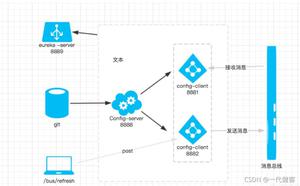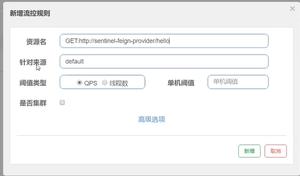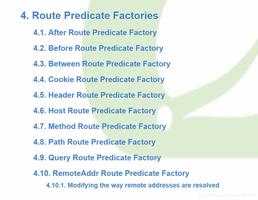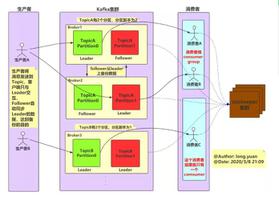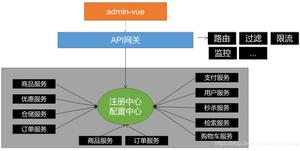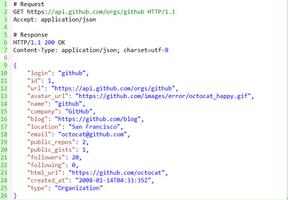SpringCloud分布式配置中心浅谈

二、使用配置中心的好处
当我们系统业务扩展到一定程度的时候;免不了会增加很多的配置文件和信息,例如证书文件、接口对接的参数信息、数据库连接信息等;传统的单体式架构系统,SSH、SSM还是Struts等,只能是一个文件一个文件的增加堆积到项目系统中。每次更改配置信息的时候,都要重启服务器,影响线上业务浪费时间等。当配置文件数量达到一定程度的时候,整个项目就会看起来非常臃肿冗余,更甚者可能会拿错配置信息导致程序崩溃等。那么,这时候分布式系统采用的配置中心的优势就突出出来了。由业务拆分的多个模块系统的各配置文件,全部配置在配置中心统一管理;与程序分离,做到动态配置获取配置信息。无需重启服务器即可动态刷新加载配置信息。
GitLab的使用见另一篇文章:GitLab的使用和优势
三、SrpingCloudConfig基本配置原理
- git 上存放我们的远程配置文件
- config-server 连接到 git
- config-client 连接到config-server
- 当我们启动config-client 服务的时候,client 会通过连接的 config-server 拿到远程git 上面的配置文件,然后通过 Spring 加载到对象中
1、搭建Config Server注册中心
pom.xml依赖
<dependency> <groupId>org.springframework.cloud</groupId>
<artifactId>spring-cloud-config-server</artifactId>
</dependency>
创建Spring Boot的程序主类,并添加@EnableConfigServer注解,开启Config Server
@EnableConfigServer@SpringBootApplication
public class Application {
public static void main(String[] args) {
new SpringApplicationBuilder(Application.class).web(true).run(args);
}
}
application.properties中配置服务信息以及git信息;由于开发完成后,Config Server的svn权限以及配置信息等,都已做了限制权限,没法查阅。
简单介绍下:
# gitLab管理配置,仓库位置,连接信息,url等# gitLab用户名
# gitLab密码
配置仓库中,根据不同环境新建了下面四个配置文件:
- didispace.properties
- didispace-dev.properties
- didispace-test.properties
- didispace-prod.properties
同时创建一个config-label-test分支,并将各配置文件中的值用2.0作为后缀
URL与配置文件的映射关系如下:
- /{application}/{profile}[/{label}]
- /{application}-{profile}.yml
- /{label}/{application}-{profile}.yml
- /{application}-{profile}.properties
- /{label}/{application}-{profile}.properties
搭建好config Server后,就把服务注册到Eureka;经过zuul进行路由转发,以供各个服务模块可以调用。
Zuul的原理和使用介绍见另一篇文章:SpringCloud的路由网关Zuul简单使用介绍
2、客户端config Client调用服务端Server获取配置
整个系统只能有一个Config Server服务中心,其他模块只能作为客户端config Client注册到Eureka中,然后读取服务中心的配置信息。(SpringCloud的生态决定,不能有多个服务中心)
pom.xml依赖
<dependency> <groupId>org.springframework.cloud</groupId>
<artifactId>spring-cloud-starter-config</artifactId>
</dependency>
创建bootstrap.properties配置,来指定config server
#bootstrap.properties的加载也是先于application.properties#bootstrap.properties配置,来指定config server
#对应前配置文件中的{application}部分
spring.application.name=didispace
#对应前配置文件中的{profile}部分
spring.cloud.config.profile=test
#对应前配置文件的git分支
spring.cloud.config.label=config-label-test
#配置中心的地址
spring.cloud.config.uri=http://localhost:7001/
#spring boot port
server.port=7002
- spring.application.name:对应前配置文件中的{application}部分
- spring.cloud.config.profile:对应前配置文件中的{profile}部分
- spring.cloud.config.label:对应前配置文件的git分支
- spring.cloud.config.uri:配置中心的地址
上面这些属性必须配置在bootstrap.properties中,config部分内容才能被正确加载。因为config的相关配置会先于application.properties,而bootstrap.properties的加载也是先于application.properties。
创建最基本的Spring Boot启动主类
@SpringBootApplicationpublic class Application {
public static void main(String[] args) {
new SpringApplicationBuilder(Application.class).web(true).run(args);
}
}
config-client 工程中添加依赖监控模块,其中包含了/refresh刷新API
<dependency> <groupId>org.springframework.boot</groupId>
<artifactId>spring-boot-starter-actuator</artifactId>
<optional>true</optional>
</dependency>
在需要自动更新配置变量的Java类上,使用注解 @RefreshScope 修饰
以后当我们再更新git上面的配置文件后,在 config-client 端执行POST 请求 http://localhost:8080/refresh 就可以更新刷新配置变量到内存中了。
这样就做到,配置一个Config Server注册中心,在Gitlab下配置各模块和对应环境的配置信息;Confid Client通过Eureka经由Zuul网关路由读取到对应的配置;达到动态分布式配置中心读取的效果。
关注公众号:程序大视界
觉得对你有帮助,关注博客和公众号。不定期分享最新前沿技术框架和bat大厂常用技术等,加群不定期分享行业内大牛直播讲课以及获得视频课件资料等。
以上是 SpringCloud分布式配置中心浅谈 的全部内容, 来源链接: utcz.com/z/516484.html

